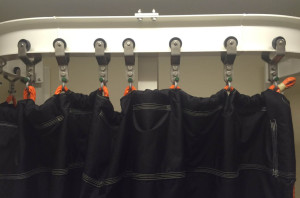
Auxetic materials find their way into new applications and markets.
Auxetic materials, which exhibit counter-intuitive properties known as a negative Poisson’s ratio, are inspiring textiles with applications in the fields of wound care, personal protective equipment, and industrial safety. Developments in the field of auxetic textiles were the subject of a symposium this year at Techtextil N.A. in Atlanta.
Andrew Alderson, Principle Research Fellow at the Materials and Engineering Research Institute (MERI) at Sheffield Hallam University, explained that Poisson’s ratio is the ratio of transverse contraction strain to longitudinal extension strain in the direction of stretching force. Auxetic materials, which become thicker perpendicular to the direction of stretch, are described as having a negative Poisson’s ratio.
“Auxextic materials are a route to achieve properties that are not easy to achieve,” said Alderson. Under compression, an auxetic material becomes denser, exhibiting enhanced fracture toughness, stiffness, and shear rigidity. When bent, an auxetic material forms a dome shape.
Variety in types and function
There are several routes to creating auxetic textiles, and auxetic monofilaments have been spun through the partial melt process, including polypropylene, polyester, and nylon. These monofilaments can be knit as rib-knit or warp-knit structures, or can be woven or used in needle-punched nonwovens.
For example, auxetic monofilaments impregnated with a healing agent could be knit into smart bandage structures. When the wound swells, the monofilaments expand to open up the structure and release the medication. As the wound heals, the monofilaments relax and the bandage’s micropores close, stopping the release of the medication.
Anderson also spoke about the use of auxetic materials in personal protective equipment, explaining that seashells exhibit this kind of protection with a layer of auxetic nacre found beneath the rigid outer shell. Also known as mother of pearl, the nacre protects the organism from predators with its stiffness, strength, and toughness.
Professor Hong Hu of the Institute of Textiles & Clothing at Hong Kong Polytechnic, along with his colleagues, has identified a number of impact protection applications for 3D auxetic warp-knit spacer fabrics. The textiles are knit using double warp knitting machines with six guide bars, creating a hexagonal geometry, which is compressed and heat set. The fabrics are finished with an impact hardening polymer which becomes rigid on impact.
The hexagonal structure of the textile exhibits better comfort, flexibility, and breathability compared to the foams commonly used for impact protection. The nonconventional behavior of auxetic structures creates a better fit when used in helmets, and elbow and knee pads. Auxetic spacer fabrics may also find applications in military uniforms, mattresses and mats, and protective bags and packaging materials.

Blast containment
David O’Keefe, president of Advanced Fabric Technologies (AFT), described the company’s Xtegra™ system of blast-containment curtains which combines auxetic yarns and high-temperature and fire-resistant basalt materials. The system is based on a helical auxetic yarn (HAY) which is a compliant core yarn wrapped with a finer, stiffer yarn.
Xtegra™ portable, easily assembled blast-containment systems are being used by offshore oil rigs to protect the drilling deck during manifold pressure tests, and by the military for blast waves and fragment or debris containment. AFT’s patented auxetic technology can protect power infrastructures and electrical grids from sabotage or terrorism. The concept is also applicable to mining and manufacturing operations, and is being studied as a replacement for current automotive airbag textiles.
“The introduction of auxetic ‘smart yarns’ can enhance products or create new platforms. This capability allows auxetic yarns to be used in multiple disciplines,” O’Keefe says.
The potential for auxetic textiles also extends to the booming field of composites, according to Anderson, where they could improve fiber pullout resistance in composite systems. And auxetics are becoming the latest buzzword for performance textiles for active sportswear brands, where Under Armour has been first to the post with its ClutchFit™ shoe and compression technology. The material was designed and built to be flexible but respond when it’s put under pressure.
Auxetic materials would appear to be well on their way to providing us with new dimensions in textile structures and end uses.
Debra Cobb is a freelance writer with extensive experience in the textiles industry.
 TEXTILES.ORG
TEXTILES.ORG


